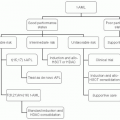Chemotherapy-Induced Renal and Electrolyte Dysfunction
Harbaksh Sangha
Ramesh Khanna
The chemotherapeutic drugs that are filtered, secreted, and cleared by the kidneys have the potential to cause acute and chronic kidney injury. The kidney damage varies from mild elevation of creatinine and simple electrolyte dysfunction to severe injury requiring dialysis.
Impaired renal function, by decreasing the rate of drug elimination, prolongs the duration of drug exposure and subsequent drug toxicity. Thus, accurate evaluation of renal function is crucial before a chemotherapeutic drug is started.
Evaluation of renal function involves the following:
Glomerular filtration rate (GFR) estimation, to determine the presence of preexisting renal dysfunction (e.g., loss of nephron mass) and to adequately dose chemotherapeutic medications cleared by the kidneys.
Tubular function, to monitor drug toxicity.
GLOMERULAR FILTRATION RATE
The GFR can be estimated from plasma clearance of filtration markers by the kidneys. An ideal filtration marker should be nontoxic with no secretion, reabsorption, or metabolization in the renal tubules. In routine clinical practice, estimating GFR with such ideal filtration markers (inulin and iothalamate) is complex and expensive. One of the prerequisites to estimating GFR, is to have steady state kidney function.
In practice, creatinine clearance estimation is commonly employed to assess the GFR. Creatinine is an endogenous filtration marker derived from dietary meat and metabolism of creatine in skeletal muscle. Fall in GFR is reflected in high levels of serum creatinine. Plasma levels of creatinine stay constant in a steady state, making it a good marker of renal function. The shortcomings of estimating GFR using serum creatinine are as follows:
Creatinine is secreted from the renal tubules, thus overestimating the true GFR. This is of particular concern in severe kidney dysfunction when creatinine secretion accounts for a significant proportion of creatinine clearance in the urine.
There may be interlab oratory variation in calibration resulting in differences in serum creatinine (0.23 mg per dl in one study) in the same sample.1 Additionally, noncreatinine chromogens like glucose, vitamin C, cephalosporins can interfere with the plasma creatinine assay. Standardization of the creatinine assay has eliminated this problem to a great extent.
Patients may not be in a steady state. Cancer patients are usually hypercatabolic resulting in higher levels of serum creatinine from muscle breakdown. There may be excess creatinine from changes in dietary meat or release from injured muscle, as in rhabdomyolysis.
In acute renal failure, change in serum creatinine lags behind the change in true GFR by hours to days.
Cockcroft-Gault2 and Modification of Diet in Renal Disease (MDRD)3 equations are used to assess the GFR from the serum creatinine. These equations may not be accurate in extremes of ages, weights, and kidney function and populations other than U.S. Caucasians and African Americans.4,5,6 They may also be inaccurate in the renal transplant population.7
Twenty-four-hour urine collection for creatinine and urea can be used to determine clearance to overcome some of the following shortcomings:
Urea is reabsorbed from the renal tubules and nullifies the overestimation of creatinine clearance because of creatinine secretion from the tubules.
Body size can be accounted for by adjusting for body surface area.
Cimetidine can be used to block creatinine secretion, thus avoiding the overestimation of GFR in advanced kidney dysfunction.
Twenty-four-hour urine collection for GFR estimation may be prone to collection errors and does not reflect acute changes in the kidney function.
If doubts persist, nuclear studies such as technetium-99m DTPA or MAG3 (readily available in most tertiary care centers) should be considered to assess the GFR. Tubular function is assessed by analyzing serum and urine electrolytes and assessing sodium and water balance.
RISK FACTORS FOR KIDNEY INJURY
Risk factors for preexisting kidney dysfunction and potential injury from chemotherapeutic drugs include age >60 years, hypertension, diabetes, cardiovascular disease, and family history of renal disease.8,9 Other factors include concomitant use of nonsteroidal anti-inflammatory drugs, intravascular volume depletion (because of excessive gastro-intestinal (GI) losses, reduced intake, or fluid sequestration), and urinary tract obstruction secondary to underlying tumor.8 Patients with multiple myeloma are also at risk for prerenal uremia from hyperviscosity syndrome.
URIC ACID NEPHROPATHY
Uric acid is filtered by the glomeruli and reabsorbed and secreted by the renal tubules. As the principal end product of purine metabolism, its excretion may increase significantly in some malignancies or in response to therapy. Its highest concentration occurs in the distal tubule, the area of the kidney responsible for acidification of urine. Uric acid has decreased solubility in an acid medium, which accounts for the renal dysfunction in acute uric acid nephropathy. Acute uric acid nephropathy develops when excess uric acid production and excretion exceed the solubility in the distal tubule and collecting ducts resulting in crystal precipitation.
Spontaneous hyperuricemia and nephropathy may occur with some hematologic malignancies but are rare with solid tumors. Large cell non-Hodgkin lymphomas, Burkitt lymphoma, and the acute leukemias are most commonly associated with spontaneous uric acid nephropathy.10
The more common situation is the development of acute uric acid nephropathy with a dramatic response to chemotherapy or radiotherapy.11 Patients whose cancers have a high cell turnover rate, such as bulky responsive tumors, aggressive hematologic cancers, small cell lung cancer, and testicular cancer, are at a greater risk of uric acid nephropathy.Uric acid crystals loosely form in the distal tubule and collecting ducts. If treated appropriately, the abnormalities are reversible, with improvement in renal function. Uric acid calculi are rare, as the exposure to high uric acid levels is brief, but calculi can develop with chronic hyperuricemia, as observed in myeloproliferative syndromes.12 The clinical presentation of acute uric acid nephropathy is that of acute renal failure: nausea, emesis, malaise, anorexia, and oliguria.10 Flank pain and hematuria are rare, as nephrolithiasis is uncommon. Other causes of acute renal failure cannot be differentiated from uric acid nephropathy by serum creatinine, urea nitrogen, or uric acid levels.13 Serum phosphate levels may be elevated and may be associated with hypocalcemia, particularly with rapid tumor lysis.10 Uric acid crystals may be present in the urine, but their absence does not rule out the diagnosis, as the crystalluria may be seen only acutely.10 A urinary uric acid to creatinine ratio above one on a random sample is specific for the diagnosis.13
PREVENTION AND EARLY TREATMENT ARE THE PRIMARY ASPECTS OF THE MANAGEMENT OF URIC ACID NEPHROPATHY
Patients at significant risk for hyperuricemia require:
hydration, to maintain a urinary output >3 L daily (>100 ml per hour),10
urinary alkalinization, to keep urine pH>7.0 to prevent crystallization (100 mEq per m2 daily),10 and
allopurinol, 600 mg daily for 2 to 3 days, then 300 mg orally daily.
It is best if these measures can be initiated at least 48 hours before chemotherapy. Should hyperuricemia develop, prompt recognition and institution of therapy are necessary to prevent acute renal failure. If oliguria has not developed, the above measures may be adequate to reverse the abnormalities. Allopurinol may be given intravenously or orally; therapeutic levels of its active metabolite, oxypurinol, are attained within minutes by the intravenous (IV) route and within 1 to 3 hours orally.14 In the presence of anuria or oliguria, it is necessary to exclude ureteral obstruction. This is best done by ultrasound to avoid nephrotoxic contrast-based imaging studies. Once hydronephrosis is ruled out, urinary flow must be established by hydration and furosemide. If diuresis does not occur within a few hours, dialysis should be initiated. Hemodialysis is preferred, as it is more effective than peritoneal dialysis in lowering total body uric acid.
There are potential complications to the measures taken to prevent hyperuricemia. Fluid overload can occur and requires close attention to input and output. Alkalinization may cause metabolic alkalosis and associated hypokalemia.10,11 Allopurinol, which inhibits xanthine oxidase, may increase xanthine levels and cause xanthine crystals to form in acidic urine.15 Oxypurinol, the active metabolite of allopurinol, may form crystals in high-dose allopurinol administration with oliguria16; thus, the dose of allopurinol must be reduced in the presence of renal failure. Finally, rare cases of interstitial nephritis and renal failure have been related to allopurinol. The clinical picture is one of eosinophilia and exfoliative dermatitis. Management requires discontinuation of the drug and administration of corticosteroids.17
RAPID TUMOR LYSIS SYNDROME
Rapid tumor lysis syndrome (TLS) is an oncologic emergency characterized by massive cell death because of chemotherapy in extremely sensitive tumors, resulting in severe, life-threatening metabolic derangements, which must be present 3 days before or 7 days after initiating chemotherapy in the setting of adequate hydration (with or without alkalinization) and use of a hypouricemic agent. The laboratory findings include hyperkalemia (serum K >6.0 mEq per L or a 25% increase from baseline), hyperphosphatemia (serum phosphorus >6.5 mg per dl in children and >4.5 mg per dl in adults or a 25% increase from baseline, hypocalcemia (serum Ca <7.0 mg per dl or a 25% increase from baseline), and hyperuricemia (serum uric acid >8.0 mg per dl or a 25% increase from baseline). As a consequence, clinical TLS develops when acute renal failure, cardiac arrhythmias, seizure, or sudden death could ensue.18 Potassium and phosphate are released from the dying cells. Phosphate precipitates with calcium resulting in hypocalcemia and tetany.
The tumors most commonly associated with the rapid TLS are Burkitt, undifferentiated lymphomas and acute lymphoblastic leukemia.18,19 It rarely occurs in solid tumors, except in small cell carcinoma.20,21,22 An association exists between the degree of elevation of the serum lactic dehydrogenase level and the development of the syndrome.18,19 In addition, the presence of renal insufficiency or hyperuricemia increases the risk of rapid TLS, although it may occur with normal renal function. The clinical manifestations include symptoms of uremia
and tetany, occurring within 24 to 48 hours after the initiation of chemotherapy. Other abnormalities include prolongation of the QT interval, soft tissue deposition of calcium salts, and progressive azotemia.
and tetany, occurring within 24 to 48 hours after the initiation of chemotherapy. Other abnormalities include prolongation of the QT interval, soft tissue deposition of calcium salts, and progressive azotemia.
Stay updated, free articles. Join our Telegram channel

Full access? Get Clinical Tree





